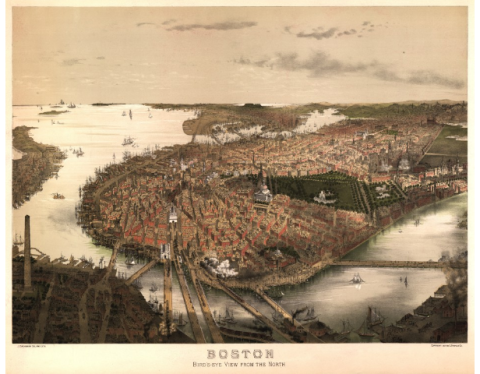Twain often visited Boston. The Lyceum lecture bureau of James Redpath; his publisher James R, Osgood; and his friend W.D. Howells, his friend and editor of the Atlantic Monthly were all there. Rasmussen remarks that Twain selected Hartford, Connecticut in 1871 for a home because it was midway between New York and Boston, with easy train connections to both. "Over the next 35 years he spoke frequently in Boston and met most of New England's leading literary figures there."
Sam wrote to Orion in 1871: There is no section in America half so good to live in as splendid old New England—& there is no city on this continent so lovely & lovable as Boston, almost in sight of which is now your high privilege to live
Sam wrote from Boston to James B. Pond, sending revised programs for two New York nights, and enclosing a letter from Orion in Keokuk, Iowa. Jan. 13 was one of the open dates there; Sam hoped he might read in Hannibal, Mo. on Jan. 12 and the next night in Keokuk. He advised Pond not to “sell the show” in Hannibal but to write to Sam’s old schoolmate, John H. Garth and he’d put Pond in touch with the right people. Sam wished to give all of his Hannibal proceeds to “some charity of the town” [MTP]." This is from Day by Dayfor November 11, 1884. According to the tour itinerary Clemens and Cable were between Melrose and Lowell on that date.
This didn\'t make sense to me at first until I received this email message:
Why do you say that? I grew up in Malden, which is just south of Melrose and maybe five miles or so north of Boston. Lowell is maybe 25 miles north of Boston. It would have been relatively easy for Twain to have spent the night after the Melrose gig to take a train into Boston for a good hotel, and have penned and posted the letter from there.
The point is that none of these places were more than an hour or so away from each other by the B&M railroad, which I\'m pretty sure existed in those days and catered to people who worked in Boston but commuted from cities and towns the trains had by then begun to turn into suburbs. When I was young, the B&M ran from North Station in Boston north through Malden and Melrose and on to Lowell, among other destinations. I think that was true in the 1880s. The train run from Melrose to Boston might have taken a half hour or so, and from Boston to Lowell maybe twice that.
November 13, 1884 at the Boston Music Hall
See reviews from the Boston Globe, Boston Post and Boston Transcript at Virginia EDU
Included in attached files is the report of "Strange Revelations"
Site Category
- Document
- DocumentStrange Revelations: (part 2) (282.51 KB)
- DocumentStrange Revelations: (part 3) (294.81 KB)
- DocumentStrange Revelations: (part 4) (71.97 KB)
